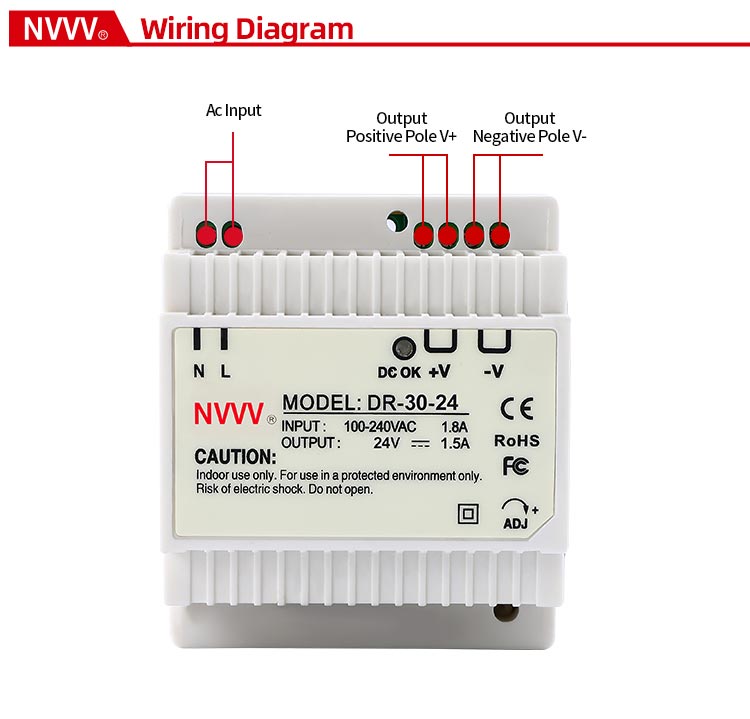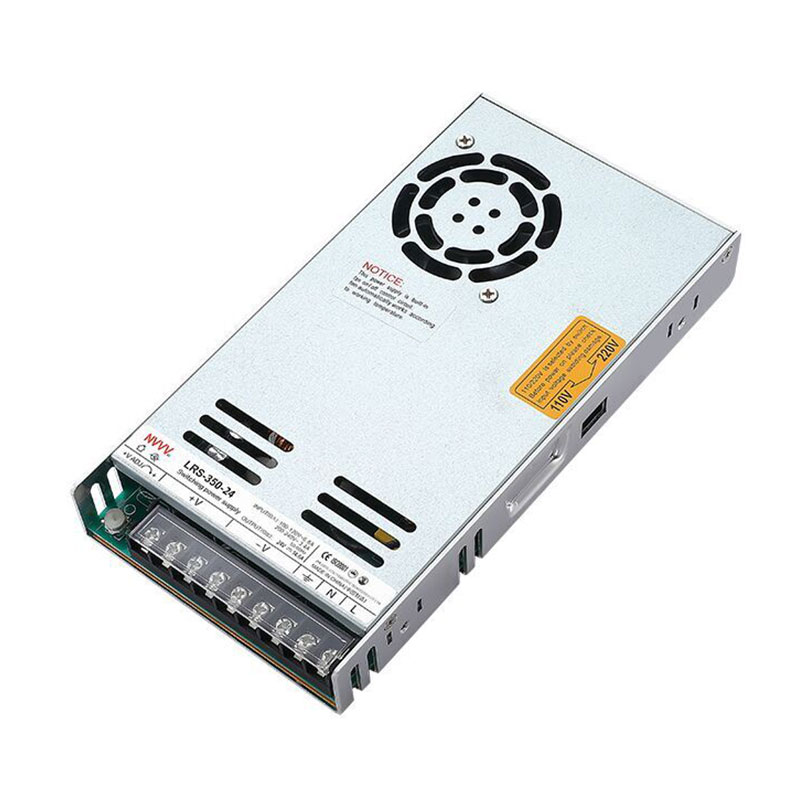What is a power supply and what types are there
Power supply plays a key role in modern electronic devices. It converts input electrical energy into voltage and current suitable for the device to ensure the normal operation of the device. From household appliances to industrial automation systems, the reliability and stability of the power supply directly affect the performance and life of the equipment.
What is a power supply?
Power supply refers to a device or system that can provide the required electrical energy to electronic equipment or circuits. Its main function is to convert the input power (such as alternating current or direct current) into a voltage and current suitable for the device to ensure the normal operation of the device. Power supply plays a vital role in various electronic devices, from simple household appliances to complex computer systems, all of which rely on a stable and reliable power supply.
Power supply usually includes the following parts:
Input: connected to the input power supply, such as AC or DC power supply.
Converter: converts the input voltage into the required output voltage and current. This part is the core of the power supply, including components such as transformers, rectifiers, filters, etc.
Output: provides a stable output voltage and current for the device to use.
Control circuit: monitors and adjusts the output voltage and current to ensure stable output and protect the power supply and equipment from overload, short circuit and other faults.
Power supplies can be divided into many types, mainly including linear power supplies and switching power supplies (SMPS).
Common power supplies and their working principles, advantages and uses
Linear Power Supply
Working principle
The basic principle of linear power supply is to use a transformer to reduce the input voltage to a voltage close to the required output voltage, then convert AC power to DC power through a rectifier, and finally output a stable DC voltage through a filter and a voltage regulator. Its working process mainly includes the following steps:
Buck: Reduce high-voltage AC power to a lower voltage through a transformer.
Rectification: Use a diode rectifier circuit to convert AC power into pulsating DC power.
Filtering: Smooth pulsating DC power through a capacitor filter to reduce fluctuations.
Voltage stabilization: Use a linear regulator (such as a linear regulator) to stabilize the filtered voltage at a specific value.
Advantages
High stability: The output voltage fluctuates little and the noise is low, which is suitable for devices with high power requirements.
Simple design: The circuit structure is relatively simple and easy to design and manufacture.
Fast transient response: The response speed to load changes is fast, and the output voltage can quickly return to stability.
Most common uses
Linear power supplies are widely used in audio equipment, laboratory power supplies, medical equipment and other occasions that require high power stability.
Switching Power Supply (SMPS)
Working principle
The working principle of the switching mode power supply is to convert the input power supply into a high-frequency pulse voltage through a high-speed switching device (such as a transistor), and then convert it into a stable DC voltage through a transformer and a filter circuit. Its working process mainly includes the following steps:
Rectification and filtering: Rectify the input AC power into DC power and perform preliminary filtering.
High-frequency conversion: Convert DC power into a high-frequency pulse voltage through a switching tube.
Transformation: Convert the high-frequency pulse voltage into the required output voltage through a high-frequency transformer.
Rectification and filtering: Rectify and filter the high-frequency pulse voltage to obtain a stable DC voltage.
Feedback control: Monitor the output voltage through the feedback circuit, and adjust the working state of the switching tube to keep the output voltage stable.
Advantages
High efficiency: Due to high-frequency switching operation, energy loss is small and conversion efficiency is high, usually reaching more than 80%.
Small size: The high-frequency transformer and filter are small in size, which greatly reduces the overall power supply volume and weight.
Strong adaptability: Able to work stably under a wide range of input voltage and load conditions.
Most common uses
Switch mode power supplies are widely used in computer power supplies, communication equipment, power tools, industrial automation equipment and other fields.
Battery Power Supply
Working Principle
Battery power supplies convert chemical energy into electrical energy through chemical reactions and directly output direct current. Depending on the type of battery, its working principle is slightly different, such as lithium battery, lead-acid battery, nickel-cadmium battery, etc.
Advantages
Strong portability: No need to rely on external power supply, suitable for mobile devices and portable applications.
High energy density: Especially lithium batteries, which have high energy density and provide long-term power supply.
High safety: Some batteries (such as lithium iron batteries) have high safety performance and stability.
Most common uses
Battery power supplies are widely used in mobile phones, laptops, portable electronic devices, cordless power tools, emergency backup power supplies, etc.
Uninterruptible Power Supply (UPS)
Working Principle
UPS system provides continuous power when the mains power is cut off through built-in batteries and inverters. It is mainly composed of rectifiers, batteries, inverters and control circuits. When the mains power is normal, the UPS converts AC power to DC power through the rectifier and charges the battery; when the mains power is cut off, the inverter converts the DC power of the battery to AC power and continues to supply power.
Advantages
Provide backup power: Provide emergency power when the mains power is cut off to prevent data loss and equipment damage.
Stable output: Filter mains power fluctuations, provide stable power supply, and protect equipment from voltage fluctuations.
Short-term power supply: Usually used to provide short-term emergency power supply so that users have time to safely shut down the equipment.
Most common uses
UPS is widely used in key occasions such as data centers, computer networks, medical equipment, and communication base stations that require uninterruptible power supply.
What should I pay attention to when choosing a switching power supply (SMPS)?
There are many factors to consider when choosing a switch mode power supply to ensure that its performance and reliability meet the application requirements. Here are some key considerations:
Output Power
Choosing the right output power is the first consideration. The output power of the power supply needs to be selected according to the actual load requirements. It is generally recommended that the rated power of the power supply should be 20%-30% higher than the load requirements to ensure that the power supply can work stably under various load conditions.
Input Voltage Range
The mains voltage and frequency may vary in different regions, so the input voltage range needs to be considered when selecting a switching power supply. Generally speaking, a wide input voltage range (such as 90-264V AC) can adapt to a wider range of application environments and increase the applicability and reliability of the power supply.
Output Voltage and Current
Choose the appropriate output voltage and current according to the requirements of the load. Make sure that the output voltage of the power supply can meet the needs of the equipment and the current capacity is sufficient for the load. In addition, it is necessary to pay attention to the adjustment range and accuracy of the output voltage to adapt to different application requirements.
Efficiency
High-efficiency switching power supplies can reduce energy loss, lower operating temperatures, and extend the service life of the power supply and equipment. Choosing a power supply with higher efficiency can not only save energy, but also reduce heat dissipation and cooling requirements, and improve the overall performance of the system.
Reliability and Lifetime
The reliability and life of the power supply are critical to the stability of the entire system. Choosing a power supply product with a well-known brand and a good reputation can ensure its stability and reliability in long-term use. In addition, factors such as the operating temperature range, shock resistance and vibration resistance of the power supply need to be considered to adapt to various environmental conditions.
Safety certification
Choosing a switching power supply that has passed international safety certification (such as UL, CE, FCC) can ensure that it complies with relevant safety standards and regulations, and ensures safety and compliance during use. Safety certification is also an important guarantee of product quality.
Physical size and installation method
Choose the appropriate power supply size and installation method according to the application. Different devices may have specific requirements for the size and installation location of the power supply. It is necessary to ensure that the physical size of the power supply can match the structure and installation location of the device for easy installation and maintenance.
Heat dissipation and cooling
The switched mode power supply will generate a certain amount of heat during operation. A good heat dissipation design can effectively reduce the temperature of the power supply and improve its stability and service life. Choosing a power supply with good heat dissipation performance, such as a design with a heat sink or fan, can ensure that it can work stably for a long time under high load.
Protection function
Choosing a power supply with perfect protection functions, such as overcurrent protection, overvoltage protection, overtemperature protection and short circuit protection, can provide timely protection when the power supply or load is abnormal, preventing damage and accidents.
Conclusion
In summary, the power supply plays a pivotal role in electronic equipment. I believe that through the explanation of this article, you will have a better understanding of the power supply. For example, choosing a suitable power supply can not only improve the performance and stability of the equipment, but also extend its service life. By understanding the working principles, advantages and applications of various power supplies, and choosing according to actual needs, you can ensure that the equipment obtains the best power support and ensures its efficient and safe operation.











